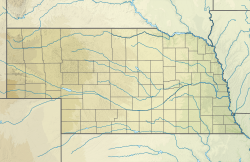| Runningwater Formation | |
|---|---|
| Stratigraphic range: Early Miocene (Hemingfordian) ~ | |
| Type | Formation |
| Lithology | |
| Primary | Sandstone |
| Other | Conglomerate |
| Location | |
| Coordinates | 42°24′N103°00′W / 42.4°N 103.0°W |
| Approximate paleocoordinates | 43°06′N99°06′W / 43.1°N 99.1°W |
| Region | Nebraska |
| Country | United States |
The Runningwater Formation is a geologic formation in Nebraska. It preserves fossils dating back to the Hemingfordian of the Early Miocene of the Neogene period. The sandstones and conglomerates of the formation were deposited in a fluvial environment. The formation has provided many fossil mammals.

